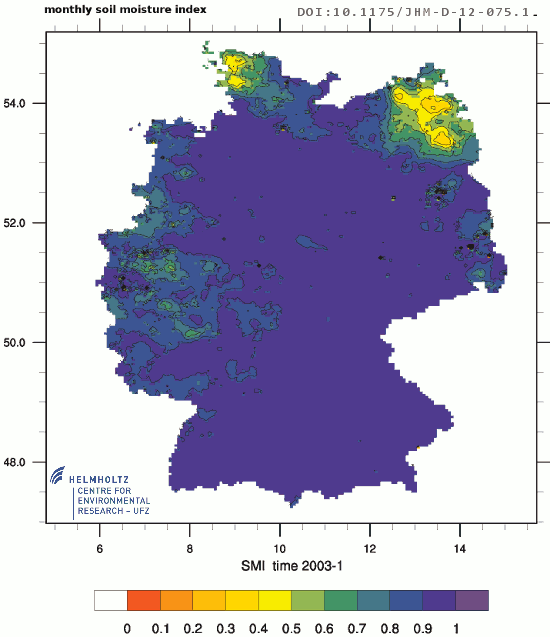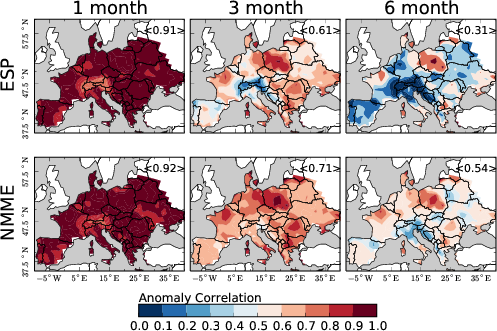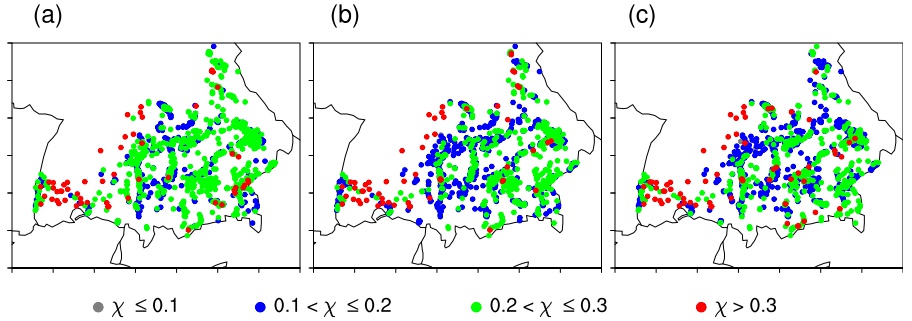Drought Analysis and Prediction
Soil Moisture Drought Analysis in Germany
 Monthly Soil Moisture Index for Germany 2003
Simulated soil moisture is increasingly used to characterize agricultural droughts but its parametric uncertainty, which essentially affects all hydrological fluxes and state variables, is rarely considered for identifying major drought events. We used the mesoscale hydrologic model (mHM) to create an ensemble of daily soil moisture fields over Germany at the spatial resolution of 4 × 4 km2 from 1950 to 2010. These high resolution data sets are then used to derive a hydrologically consistent soil moisture index (SMI) which allows characterizing historical (agricultural) drought events and their related characteristics such as coverage area, duration, and severity. Results of this study indicated that the large parametric uncertainty inherent to the model, did not allow discriminating major drought events without a significant classification error. The parametric uncertainty of simulated soil moisture exhibited a strong spatio-temporal variability, which significantly affects all derived drought statistics. Drought statistics of events occurring in summer with at most six months duration were found to be more uncertain than those occurring in winter. Based on the ensemble drought statistics, the event from 1971 to 1974 appeared to have 67% probability of being the longest and most severe drought event since 1950. Results of this study emphasize the importance of accounting for the parametric uncertainty for identifying benchmark drought events as well as the fact that using a single model simulation would very likely lead to inconclusive results.
Monthly Soil Moisture Index for Germany 2003
Simulated soil moisture is increasingly used to characterize agricultural droughts but its parametric uncertainty, which essentially affects all hydrological fluxes and state variables, is rarely considered for identifying major drought events. We used the mesoscale hydrologic model (mHM) to create an ensemble of daily soil moisture fields over Germany at the spatial resolution of 4 × 4 km2 from 1950 to 2010. These high resolution data sets are then used to derive a hydrologically consistent soil moisture index (SMI) which allows characterizing historical (agricultural) drought events and their related characteristics such as coverage area, duration, and severity. Results of this study indicated that the large parametric uncertainty inherent to the model, did not allow discriminating major drought events without a significant classification error. The parametric uncertainty of simulated soil moisture exhibited a strong spatio-temporal variability, which significantly affects all derived drought statistics. Drought statistics of events occurring in summer with at most six months duration were found to be more uncertain than those occurring in winter. Based on the ensemble drought statistics, the event from 1971 to 1974 appeared to have 67% probability of being the longest and most severe drought event since 1950. Results of this study emphasize the importance of accounting for the parametric uncertainty for identifying benchmark drought events as well as the fact that using a single model simulation would very likely lead to inconclusive results.
For further reading, refer to 10.1175/JHM-D-12-075.1
Based on this study, the German Drought Monitor was initiated.
For further informtion please contact Rohini Kumar, Luis Samaniego
Drought Forecasting in Europe using the National Multimodel Ensemble
Drought forecasting systems incorporate seasonal meteorological forecasts to estimate future drought conditions. Meteorological forecasting skill, however, in particular that of precipitation, is limited to a few weeks because of the chaotic behavior of the atmosphere. One of the most important challenges in drought forecasting is to understand how the uncertainty in the atmospheric forcings (e.g., precipitation) is further propagated into hydrologic variables such as soil moisture.
A large atmospheric ensemble has the potential to overcome the aforementioned challenge. The North-American Multi-Model Ensemble (NMME) is the latest collection of a multi-institutional seasonal forecasting ensemble and allows to test the hypothesis that a large meteorological ensemble increases drought forecasting skill at various lead times. Furthermore, the forecast provided by these dynamical models is compared to that of a simple statistical forecasting model, which resamples historic meteorological conditions to create an ensemble of future forcings (Ensemble Streamflow Prediction - ESP based approach).
Results indicate that the full NMME leads to more precise drought forecasts than the ESP method for lead times up to six months. The anomaly correlation quantifying the match of temporal soil moisture dynamics (see Figure below) is comparatively higher for NMME as compared to ESP. However, a substantial spatial variability can be observed for both NMME and ESP forecasts with lesser skill (i.e., anomaly correlation) in mountainous regions like the Alps.
See also the REKLIM site for further information.
 Soil Moisture anomaly correlation
Soil Moisture anomaly correlation
Groundwater drought
In this project we attempt to understand the applicability of the commonly used standardized precipitation index (SPI) to characterize groundwater droughts. We used monthly groundwater heads and precipitation records for more than 1200 wells located in south Germany to address this issue. The standardized anomalies in the groundwater heads (SGI) were correlated against their respective SPIs at different accumulation periods of the precipitation. We find a substantial spatial variation in accumulation periods to achieve maximum correlation between SPI and SGI time series. Further, the false alarm rate (shown in Figure 3) in the order of 0.2 - 0.3 at the majority of the wells demonstrates the low reliability of groundwater drought predictions using the SPI. The evidence presented in this study regarding the inability of the SPI to characterize groundwater drought events calls for a different observation-based indicator like the SGI. If for data availability reasons, the precipitation-based drought indicator is used for groundwater drought studies, the limitations should be borne in mind.
 Figure 3: The false alarm rate (χ) to detect groundwater drought using (a) 3, (b) 6, and (c) 12-month SPI for German wells. Around 66%, 51%, and 52% of the wells have χ≥0.2 at the three accumulation periods.
Figure 3: The false alarm rate (χ) to detect groundwater drought using (a) 3, (b) 6, and (c) 12-month SPI for German wells. Around 66%, 51%, and 52% of the wells have χ≥0.2 at the three accumulation periods.
Contact person: Rohini Kumar. This project is performed in collaboration with Dr. Jude Musuuza (University of Bristol, UK)
